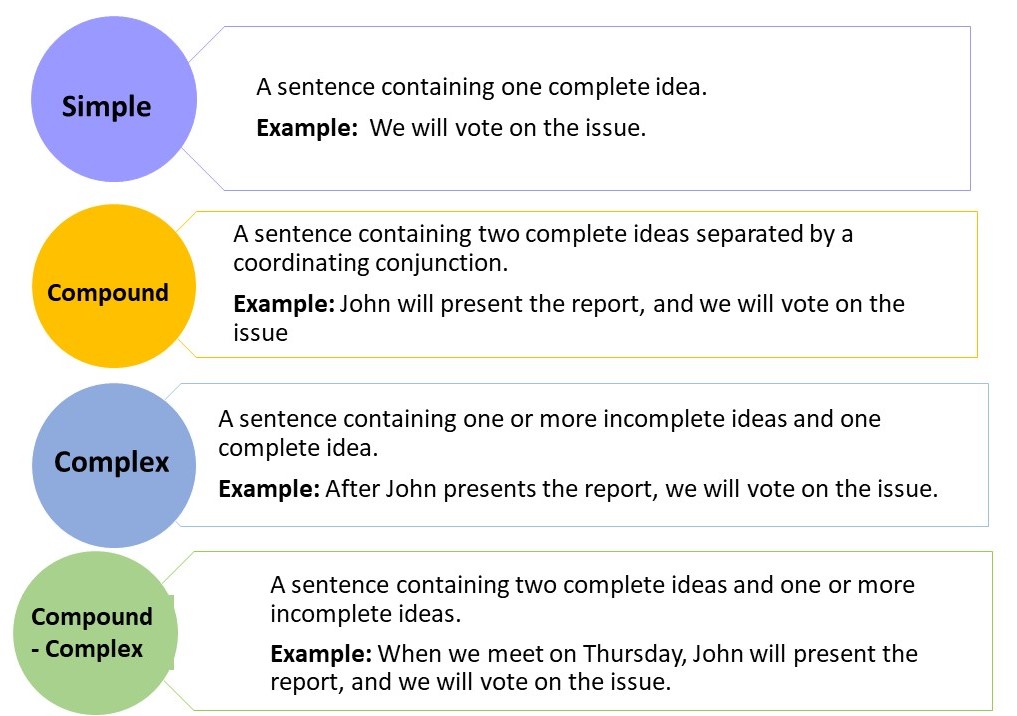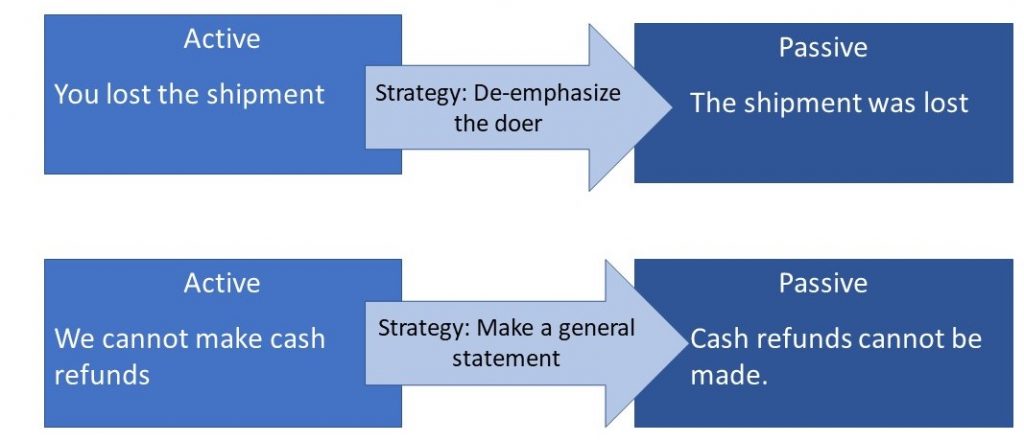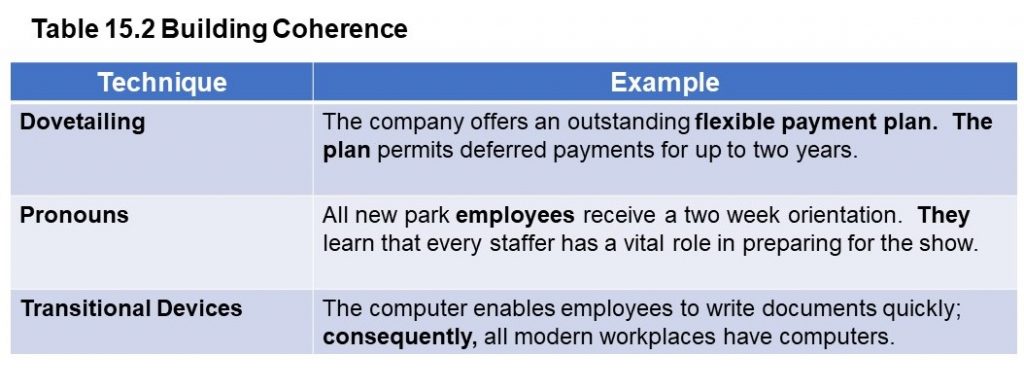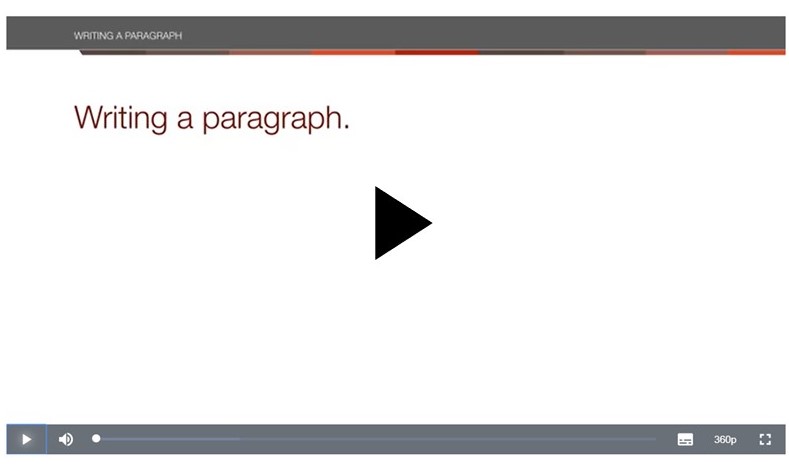Unit 15: Sentences and Paragraphs
Learning Objectives
 After studying this unit, you will be able to
After studying this unit, you will be able to
-
-
- understand different sentence types
- develop direct and indirect paragraphs
- construct active and passive sentences
-
Introduction
Showing your writing abilities involves understanding how to structure sentences and paragraphs. structure. Clear, error-free and context-specific sentences create well-developed paragraphs and improve the likelihood of clear with an audience. Understanding different types of sentences and paragraph structures will make you an effective communicator in business.
Types of Sentences
Determining how to arrange your words to communicate a clear and coherent idea takes skill. The key to developing this skill is to understand how to construct the four types of sentences: simple, compound, complex, and compound-complex. Each type of sentence has its own distinctive quality and purpose. Table 15.1 explains each type of sentence and their structure.

Tone
Your writing is an expression of you and involves how you choose and use your words to develop ideas and build paragraphs. These factors will communicate a certain tone to your writing or a reader’s perception of the message: friendly, helpful, angry, demanding, or combative. At all times, you want to ensure you communicate goodwill and a helpful tone to your reader. Choosing to write in the active or passive voice and using courteous and polite language will help you communicate the right tone in your writing.
Writing Skill 15.1 – Active and Passive Language: When a sentence is structured so the subject of the sentence is the doer of the action, you are using the active voice. The active voice produces short, direct, easy-to-read sentences that communicate good/neutral information by emphasizing the doer of the action (the “you” view). For these reasons, most of your business writing will be done using the active voice.

On the other hand, when the subject in a sentence is receiving the action, you are using the passive voice. The passive voice produces indirect, formal, vague, and longer sentences. In business communications, the passive voice is used in very specific situations:
- To de-emphasize bad news or a mistake
- To show tact and allow diplomacy
- To de-emphasize the doer of the action
Although, the active voice is used most often in business, sometimes the passive voice is a better strategy to communicate your message. When an error has been made or negative news must be delivered, using the active voice will make your writing sound accusatory or unsympathetic. Review Figure 15.3 for examples of when using the passive voice creates a better tone in your writing.

Writing Skill 15.2 – Positive Language: Generally, readers are more receptive to positive or neutral news than negative news. Using positive language will make your message reader-friendly. In addition, positive language conveys more information, is instructive, is forward looking, and communicates goodwill. The trick to positive writing is avoiding negative words with negative connotations. Table 15.1 provides a list of some negative words and their connotations when included in your writing.
Table 15.1 Avoiding Negative Phrases

To ensure your writing is positive:
- Provide instructions on how to accomplish a task.
- Tell the reader what is possible.
Effective writers pay attention to the construction of sentences. Careful and thoughtful use of words and phrases can be challenging. Thus, continually working on this area of business writing will improve your ability to create well-crafted messages for your audience.
The Paragraph
Paragraphs are the building block of all business documents. Paragraphs will vary in length and form, but all paragraphs have three essential components: unity, organization, and coherence. It doesn’t matter if you were taught the PEEL, TEEL, or hamburger method of paragraph development, knowing how to arrange the elements of a paragraph will help you clearly communicate your message to the receiver.
Unity
The first sentence in a paragraph is the topic sentence which introduces the subject or general idea that will be developed in the paragraph. Supporting sentences that support, expand, and clarify the topic such as examples, illustrations, and facts and statistics gives the paragraph its unity.
Organization
What information comes first, the topic sentence or the supporting sentence will depend on if the paragraph the direct or indirect approach.
Direct Paragraphs: Direct paragraphs start with the main idea (topic sentence) followed by the supporting sentences (explanation). As was discussed earlier, most business writing follows the direct plan. Routine information, good news, or non-sensitive messages use the direct approach as readers want to immediately understand the main reason for the communication.

Indirect Paragraphs: Indirect paragraphs use the opposite organizing pattern. These paragraphs begin with the supporting sentence to provide an explanation, clarification, or justification before providing the Main idea (topic sentence). The indirect pattern is used to deliver bad news, sensitive information, or to persuade the reader. This organizing pattern allows the writer to explain or justify the main point of the message presented in the topic sentence so the reader is more likely to accept the message.

Coherence
Coherence refers to the way ideas in a paragraph are connected and linked together. The ideas in well-written paragraphs are logically connected and lead the reader smoothly throughout the paragraph. When paragraphs are coherent, a group of sentences in a sequence will “make sense” and readers will understand how the sentences work together to communicate the complete message. When paragraphs are incoherent, sentences lack flow and not logically fit together. To ensure your paragraphs are coherent, use one or a combination of the following techniques.
Dovetailing: When the topic that ends one sentence, begins the next. Dovetailing helps to connect sentences by repeating keywords. A reader will recognize the connection by the repeated keywords.
Pronouns: Combine pronouns with a noun to which each refers. Using pronouns in this way helps to build continuity between sentences while cutting down on repetition. When using pronouns without the helping noun, ensure that pronoun reference is clear.
Transitional Devices: Transitional words and expressions act as two-way indicators of what has been said and what is going to be said. Furthermore, therefore, consequently, and however are all examples of transitional words. Because there are so many transitional words and expressions, understanding what each means and which word or expression is correct for a specific sentence takes practice. Using the wrong word or expression can change the meaning of a sentence and cause miscommunication. Transitional devices can be used to
- Add an idea
- Show contrast or comparison
- Provide an example or illustration
- Summarize or conclude a thought
- Demonstrate chronology
- Show cause or effect
Table 15.2 shows how to use dovetailing, pronouns, and transitional devices to achieve coherence.

No that we’ve gone through the parts, qualities, and characteristics of an effective business paragraph, view the video below for a demonstration of how to put these components together.

Key Takeaways

-
-
- Understanding the four types of sentences is important to developing well-crafted paragraphs.
- use active, passive, and positive language to create a reader-friendly tone in your writing
- Paragraphs have three important components: unity, organization, and coherence.
-
Exercises
 1. Assemble a Six-
1. Assemble a Six-
References
Bovee, C.L., Thill, J. V., & Scribner J. A. (2016) Business communication essentials (4th ed.). Don Mills, ON: Pearson Canada Inc..
Coursera. (2020). Writing a paragraph [Video file]. University of Colorado Boulder. Retrieved from https://www.coursera.org/lecture/writing-for-business/writing-a-paragraph-4Uq3V
Guffey, M., Loewry, D., & Griffin, E. (2019). Business communication: Process and product (6th ed.). Toronto, ON: Nelson Education. Retrieved from http://www.cengage.com/cgi-wadsworth/course_products_wp.pl?fid=M20b&product_isbn_issn=9780176531393&template=NELSON
Tells you what can be done instead of what cannot be done. Tells you what is possible instead of what is not possible.
Point, Elaborate, Evaluate, Link
Topic, Explanation, Evidence, Link
providing good, routine, and non-sensitive information.
A paragraph that communicates, bad, sad or sensitive information. In addition, a paragraph that aims to persuade the reader.

